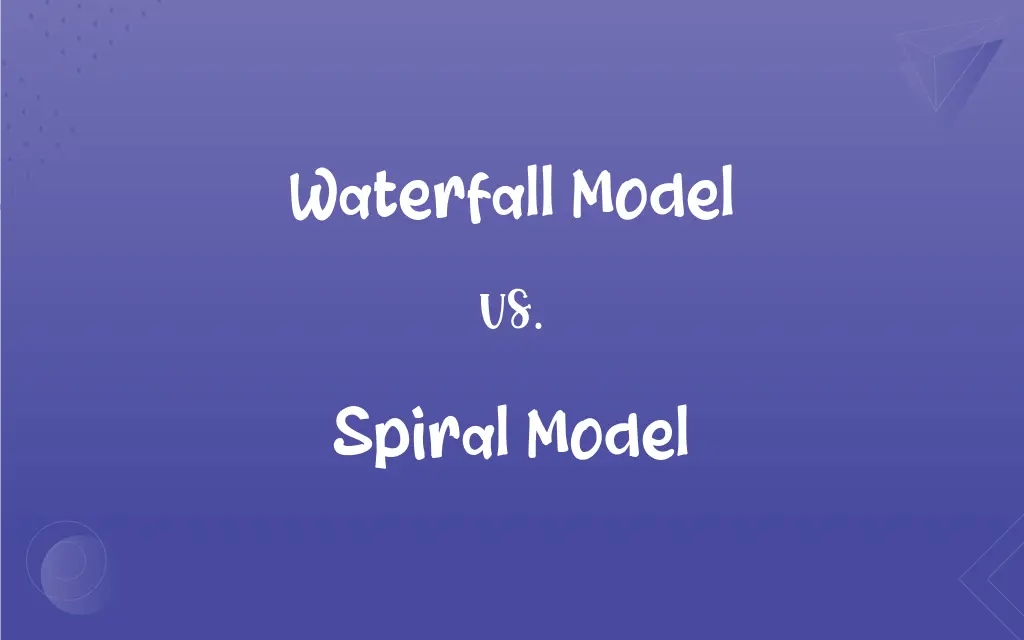Waterfall Model vs. Spiral Model: What's the Difference?
Edited by Aimie Carlson || By Janet White || Published on February 28, 2024
The Waterfall model is a linear, sequential approach to software development, while the Spiral model combines iterative development with risk management elements.

Key Differences
The Waterfall model is characterized by a linear and sequential approach where each phase must be completed before the next begins. In contrast, the Spiral model is iterative, allowing for multiple rounds of refinement and development.
Waterfall model’s rigid structure makes it less adaptable to changes, ideal for projects with well-defined requirements. The Spiral model is more flexible, accommodating evolving requirements, making it suitable for complex and high-risk projects.
In the Waterfall model, risks are generally identified and addressed during the initial stages. The Spiral model, however, continuously evaluates and mitigates risks throughout the development process.
The Waterfall model typically involves customer feedback at the beginning and the end of the project. In the Spiral model, customer feedback is integral at each iteration, allowing for more customer engagement and satisfaction.
The Waterfall model is often preferred for smaller projects with clear requirements. The Spiral model is better suited for larger, more complex projects where requirements are expected to evolve.
ADVERTISEMENT
Comparison Chart
Process Type
Linear and Sequential
Iterative and Cyclical
Flexibility
Low, difficult to accommodate changes
High, accommodates changes well
Risk Management
Limited, primarily in initial stages
Continuous risk analysis and mitigation
Customer Involvement
Minimal, mainly at beginning and end
High, throughout each iteration
Suitability
Best for small projects with clear requirements
Ideal for large, complex, and high-risk projects
ADVERTISEMENT
Requirement Clarity
Requires clear, defined requirements at start
Can handle evolving requirements
Feedback Integration
Limited to specific phases
Continuous feedback integration
Project Visibility
Lower, due to sequential nature
Higher, through frequent iterations
Cost Estimation
Easier, due to defined scope
More challenging, due to evolving nature
Documentation
Emphasized and extensive
Less emphasis, more flexibility in documentation
Waterfall Model and Spiral Model Definitions
Waterfall Model
The Waterfall model requires clear, defined requirements from the beginning.
Before starting development, they finalized all specifications as required by the Waterfall model.
Spiral Model
The Spiral model allows for continuous refinement of the product through iterative cycles.
Each spiral enabled them to refine the software based on user feedback and testing results.
Waterfall Model
Changes or revisions are difficult once a phase is completed in the Waterfall model.
After completing the design phase, making changes was challenging as per the Waterfall model's structure.
Spiral Model
It emphasizes risk analysis and reduction throughout the development cycle.
At every spiral, they conducted a risk assessment to mitigate potential issues.
Waterfall Model
This model is typically used for smaller projects with well-understood requirements.
For their small-scale application, they chose the Waterfall model due to its simplicity and clarity.
Spiral Model
The Spiral model is an iterative software development process combining elements of design and prototyping.
Using the Spiral model, they developed prototypes in each iteration to test new features.
Waterfall Model
It involves distinct phases including requirements, design, implementation, verification, and maintenance.
In the Waterfall model, they began with a comprehensive requirements analysis phase.
Spiral Model
Customer feedback is integrated into each iteration of the Spiral model.
Customer input was incorporated regularly, following the principles of the Spiral model.
Waterfall Model
The Waterfall model is a linear and sequential software development approach.
Their project followed the Waterfall model, completing each phase one after the other.
Spiral Model
This model is suitable for large, complex projects with uncertain requirements.
For their complex project, the Spiral model was ideal due to its flexibility in handling changing requirements.
FAQs
Is the Waterfall model flexible?
No, the Waterfall model is known for its rigidity and difficulty in accommodating changes.
When is the Waterfall model preferred?
The Waterfall model is preferred for small projects with well-defined and stable requirements.
What defines the Spiral model?
The Spiral model is an iterative development process focusing on risk management.
How does customer feedback work in the Spiral model?
In the Spiral model, customer feedback is integrated regularly during each iteration.
What is the Waterfall model?
The Waterfall model is a linear, phase-by-phase software development approach.
How does the Spiral model manage risks?
The Spiral model continuously assesses and mitigates risks throughout its iterative cycles.
Is customer involvement high in the Waterfall model?
Customer involvement is typically minimal and occurs mainly at the beginning and end in the Waterfall model.
Are changes easy to make in the Spiral model?
Yes, the Spiral model's iterative nature makes it easier to incorporate changes.
What makes the Spiral model flexible?
Its iterative cycles and continuous feedback integration make the Spiral model flexible.
How does the Spiral model handle project visibility?
The Spiral model offers higher project visibility through frequent iterations and reviews.
How does the Waterfall model approach testing?
In the Waterfall model, testing is a distinct phase that occurs after the completion of the development phase.
What type of projects is the Spiral model best suited for?
The Spiral model is ideal for large, complex projects with evolving requirements.
Can the Waterfall model handle changing requirements?
The Waterfall model struggles with changing requirements due to its sequential nature.
What are the main phases of the Waterfall model?
The main phases include requirements, design, implementation, verification, and maintenance.
How is cost estimated in the Waterfall model?
Cost estimation is generally easier in the Waterfall model due to its defined scope and clear phases.
How does the Waterfall model handle documentation?
The Waterfall model typically involves extensive and upfront documentation.
Can the Spiral model start with vague requirements?
Yes, the Spiral model can start with less defined requirements and refine them over time.
Can the Spiral model be used for small projects?
While possible, the Spiral model may not be cost-effective for very small projects.
Is the Spiral model cost-effective?
The Spiral model can be costlier due to its iterative nature and continuous risk management.
Is the Waterfall model suitable for rapidly changing technologies?
No, the Waterfall model is less suitable for projects in rapidly changing technological environments.
About Author
Written by
Janet WhiteJanet White has been an esteemed writer and blogger for Difference Wiki. Holding a Master's degree in Science and Medical Journalism from the prestigious Boston University, she has consistently demonstrated her expertise and passion for her field. When she's not immersed in her work, Janet relishes her time exercising, delving into a good book, and cherishing moments with friends and family.
Edited by
Aimie CarlsonAimie Carlson, holding a master's degree in English literature, is a fervent English language enthusiast. She lends her writing talents to Difference Wiki, a prominent website that specializes in comparisons, offering readers insightful analyses that both captivate and inform.






































































